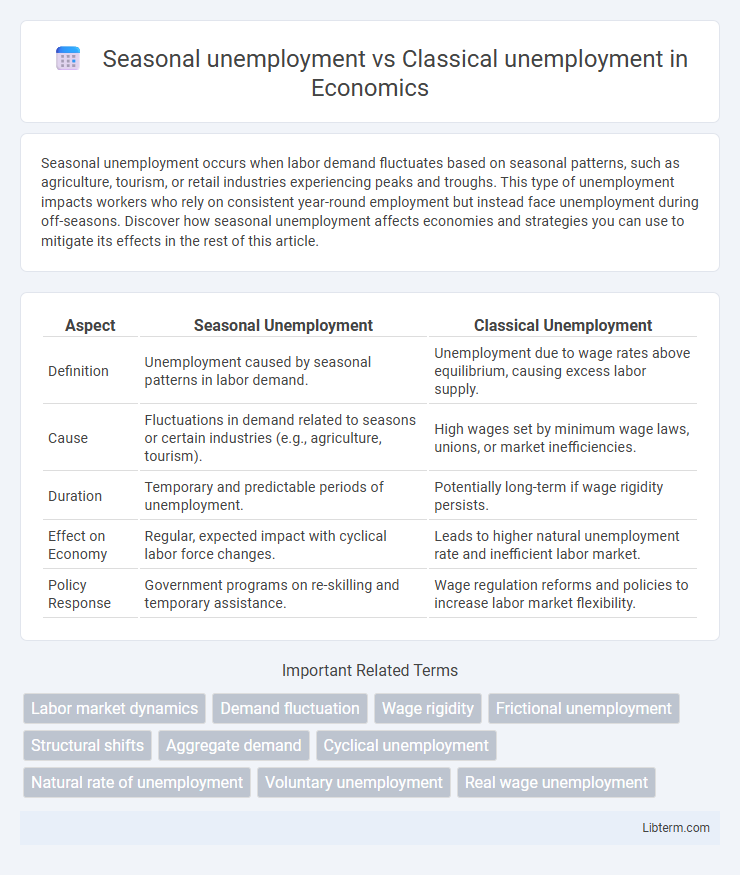Seasonal unemployment occurs when labor demand fluctuates based on seasonal patterns, such as agriculture, tourism, or retail industries experiencing peaks and troughs. This type of unemployment impacts workers who rely on consistent year-round employment but instead face unemployment during off-seasons. Discover how seasonal unemployment affects economies and strategies you can use to mitigate its effects in the rest of this article.
Table of Comparison
| Aspect | Seasonal Unemployment | Classical Unemployment |
|---|---|---|
| Definition | Unemployment caused by seasonal patterns in labor demand. | Unemployment due to wage rates above equilibrium, causing excess labor supply. |
| Cause | Fluctuations in demand related to seasons or certain industries (e.g., agriculture, tourism). | High wages set by minimum wage laws, unions, or market inefficiencies. |
| Duration | Temporary and predictable periods of unemployment. | Potentially long-term if wage rigidity persists. |
| Effect on Economy | Regular, expected impact with cyclical labor force changes. | Leads to higher natural unemployment rate and inefficient labor market. |
| Policy Response | Government programs on re-skilling and temporary assistance. | Wage regulation reforms and policies to increase labor market flexibility. |
Introduction to Seasonal and Classical Unemployment
Seasonal unemployment occurs when job availability fluctuates due to changes in seasons, affecting industries like agriculture, tourism, and retail. Classical unemployment arises from wage rigidity when wages are set above equilibrium, causing supply of labor to exceed demand. Both types highlight different labor market dynamics, where seasonal unemployment is tied to time-specific demand shifts and classical unemployment involves structural wage-price interactions.
Definitions: What is Seasonal Unemployment?
Seasonal unemployment refers to joblessness that occurs at specific times of the year when demand for labor fluctuates due to seasonal patterns, such as in agriculture, tourism, and retail sectors. Workers experience temporary unemployment during off-peak seasons when industries reduce their workforce because of changes in weather, holidays, or production cycles. This type of unemployment contrasts with classical unemployment, which arises from wage rigidity and structural mismatches in the labor market.
Understanding Classical Unemployment
Classical unemployment occurs when wages are set above the equilibrium level, causing the supply of labor to exceed demand and leading to persistent joblessness. This type of unemployment often results from minimum wage laws, labor unions, or other factors that prevent wages from adjusting downward. Understanding classical unemployment helps policymakers address structural imbalances in the labor market by promoting wage flexibility and reducing regulatory constraints.
Key Differences Between Seasonal and Classical Unemployment
Seasonal unemployment occurs due to fluctuations in demand related to seasons, affecting industries like agriculture, tourism, and retail during off-peak periods. Classical unemployment arises from wage rigidity, where wages remain above equilibrium, causing a surplus of labor and joblessness. Seasonal unemployment is temporary and predictable, while classical unemployment is structural and often requires policy interventions to address wage and labor market inefficiencies.
Causes of Seasonal Unemployment
Seasonal unemployment arises primarily from fluctuations in demand for labor during specific times of the year, such as agriculture, tourism, and holiday retail sectors experiencing reduced activity in off-peak seasons. It is caused by the predictable and recurring nature of these industries' work cycles, leading to temporary job losses when certain tasks are not required. In contrast, classical unemployment results from wage levels being set above the market-clearing rate, causing a surplus of labor supply over demand.
Causes of Classical Unemployment
Classical unemployment arises primarily from wage rigidities caused by minimum wage laws, labor unions, and employer-imposed wage floors that prevent wages from adjusting to equilibrium levels. It also results from structural mismatches in the labor market, where workers' skills or geographic location do not align with available job opportunities. Unlike seasonal unemployment, which fluctuates with predictable changes in demand across seasons, classical unemployment stems from persistent economic policies and institutional factors restricting labor market flexibility.
Economic Impact of Seasonal Unemployment
Seasonal unemployment primarily affects industries such as agriculture, tourism, and retail, leading to predictable fluctuations in labor demand that cause temporary joblessness during off-peak periods. This type of unemployment results in short-term income instability for workers and can reduce overall consumer spending in affected regions, impacting local economies cyclically. Unlike classical unemployment, which stems from wages set above market equilibrium causing prolonged joblessness, seasonal unemployment is largely driven by external environmental and market conditions inherent to specific times of the year.
Economic Impact of Classical Unemployment
Classical unemployment occurs when wages are set above the equilibrium level, causing labor supply to exceed demand and leading to prolonged joblessness. This type of unemployment results in decreased overall economic productivity and reduced consumer spending, hindering economic growth. Persistent classical unemployment can increase government expenditure on social welfare programs and strain fiscal resources.
Solutions and Policy Responses for Each Type
Seasonal unemployment requires targeted solutions such as diversifying local economies and providing retraining programs aligned with off-season industries to stabilize income throughout the year. Classical unemployment demands policy responses like improving labor market flexibility, reducing minimum wage constraints, and enhancing job-matching services to lower structural mismatches between labor supply and demand. Governments often combine unemployment insurance and active labor market programs to address both seasonal fluctuations and persistent structural barriers affecting employment levels.
Conclusion: Comparing Seasonal vs Classical Unemployment
Seasonal unemployment occurs due to predictable fluctuations in labor demand tied to specific times of the year, affecting industries like agriculture and tourism. Classical unemployment arises from rigid wages or labor market inefficiencies where wages exceed the equilibrium level, causing persistent joblessness. Comparing both, seasonal unemployment is typically temporary and cyclical, while classical unemployment tends to be more structural and long-term, requiring different policy responses for effective mitigation.
Seasonal unemployment Infographic

 libterm.com
libterm.com